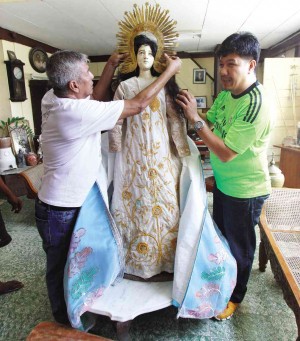Ancient images in ‘tour of saints’ in Ilocos Sur’s Candon

ALBERT Abaya, village chief of San Antonio in Candon City, Ilocos Sur, prepares the statue of the Mater Dolorosa (Sorrowful Mother). LEONCIO BALBIN JR./Contributor
CANDON CITY—Albert Abaya traces his roots to local hero, Don Isabelo Abaya, who founded the “Republic of Candon” in Ilocos Sur on March 25, 1898, to show his town and neighboring areas that they were independent from Spanish rule.
But on Holy Week, Albert becomes a hero on his own, leading the “palibot” or the saints’ tour around town.
The Abayas, by way of Albert’s great grandfather, Don Maximo Abaya, host five of the original religious statues in the Candon palibot. And considering the responsibility, preparation and security of holding on to just one, Albert has his hands full.
Let’s start with the hands. Two of the statues bequeathed to him, Mater Dolorosa and La Pieta, have ivory faces and hands.
Many years ago, one of the statues, the Lady of the Holy Rosary, was stripped of its ivory hands, face and torso, right inside the church. As a result, the Abayas dismantled the statues and hid these in different parts of the family house and other storage areas.
Only Albert and the family’s assistants knew the exact areas where these were hidden.
Albert told a story about a relative who also inherited a statue but the two surviving families were at odds so one kept the ivory hands while the other got the face.
The crowns worn by the Virgin Mary statues were also adorned with gold and diamonds. The original capes and costumes were made of velvet and gold thread.
The Abayas own the statues of San Pedro, Santo Paciencia, Mater Dolorosa, Resurreccion and La Pieta.
“These statues have corresponding lands allotted to them,” Albert said. Before Holy Week, the tenants of the land go to the Abaya house to prepare the statues and the place is like a community meeting. Some of them, like Tony Rabago Jr., have been working exclusively for the upkeep of the statues.
“It is a huge undertaking. My siblings contribute for the upkeep and in feeding the people,” Albert said.
The costumes have to be dry-cleaned and repaired by fashion designers Patis Tesoro and Greg Centeno, an Abaya relative.
Each of the carriages has to be carried by eight people with a portable power generator each. Three of the carriages are originals, all the way from Don Maximo, a nephew of Don Isabelo.
Albert said the family used to have the image of the Santo Entierro (Dead Christ) and that of San Juan de Sahagun, the town’s patron. The image of San Juan de Sahagun is now kept by the Catholic Church in Candon while that of the Santo Entierro is under the care of a relative.














